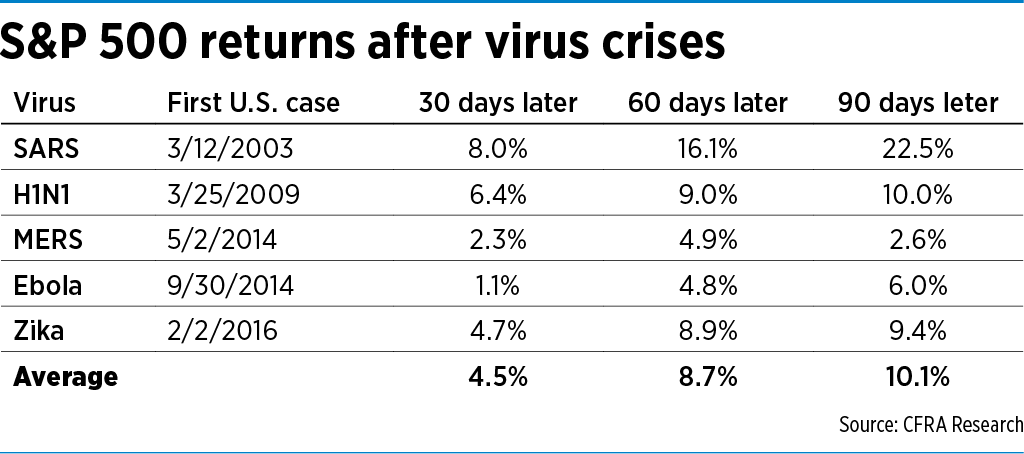Subscriber Benefit
As a subscriber you can listen to articles at work, in the car, or while you work out. Subscribe Now Our primal “fight or flight” instinct was vital for cavemen to survive, but investors must resist their natural urge to panic when stocks hit an inevitable rough patch. Whether caused by fears related to last year’s inverted yield curve or the crisis du jour, the Wuhan Coronavirus, losing your head and abandoning your plan can be deadly to long-term returns.
Our primal “fight or flight” instinct was vital for cavemen to survive, but investors must resist their natural urge to panic when stocks hit an inevitable rough patch. Whether caused by fears related to last year’s inverted yield curve or the crisis du jour, the Wuhan Coronavirus, losing your head and abandoning your plan can be deadly to long-term returns.
In fact, savvy investors who can keep their heads while others are losing theirs embrace short-term volatility as their friend that allows for returns higher than the minuscule risk-free returns earned on money markets and savings accounts. This is because timid and ill-informed investors bail out, leaving significant opportunities for those who stick with their plan and stay the course.
If you’re like me, you had never heard of a coronavirus until the scary headlines went “viral” in recent days, leading to apocalyptic predictions of impending doom and lower stock prices. I have zero informational edge on viruses but have been around long enough to know fear-driven events often create meaningful buying opportunities.
I did some snooping around and here’s what I found:
 ◗ Coronaviruses are a large group of viruses that cause diseases in mammals and birds. In humans, the virus causes respiratory infections that are typically mild but can be lethal. In rare cases, they are what scientists call zoonotic, meaning they can be transmitted from animals to humans. The name refers to the fact that the outer edge of the virus looks like the corona surrounding the sun.
◗ Coronaviruses are a large group of viruses that cause diseases in mammals and birds. In humans, the virus causes respiratory infections that are typically mild but can be lethal. In rare cases, they are what scientists call zoonotic, meaning they can be transmitted from animals to humans. The name refers to the fact that the outer edge of the virus looks like the corona surrounding the sun.
◗ The apparent source of the Wuhan Coronavirus (already the sixth major viral outbreak since 2000) was a market where live animals were sold for human consumption. As of Feb. 4, 20,438 confirmed cases and 425 deaths had been reported in China, not yet of epic proportions by historical standards.
◗ The SARS (Severe Acute Respiratory Syndrome) virus was also a coronavirus. SARS was first reported in China in November 2002 and led to 8,098 confirmed cases by July 2003 and 774 deaths.
◗ The H1N1 influenza (swine flu) was a pandemic outbreak that lasted from 2009 to 2010 and led to an estimated 151,700 to 575,400 deaths.
◗ MERS (Middle East Respiratory Syndrome) was also a coronavirus, with the first reported illness in Saudi Arabia in 2012. There were at least 2,428 confirmed cases and 838 deaths.
◗ Ebola hemorrhagic fever is a disease caused by one of five Ebola viruses. The first human outbreaks occurred in 1976 in Africa, but the biggest scare was the 2014-2016 West Africa Outbreak, which led to 11,000 deaths.
◗ The Zika virus is spread through mosquito bites and can cause birth defects and other neurological defects. In 2016, Brazil estimated as many as 1.5 million people had been infected.
It is impossible for investors to know what the eventual impact of the Wuhan Coronavirus will be in human or economic terms. However, Sam Stovall, chief investment strategist at CFRA Research, found returns for the S&P 500 were positive (some strongly so) at 30, 60 and 90 days after the first U.S. case for the prior five viral outbreaks. Past performance is no guarantee of future results, but history suggests stocks will overcome the current scare, as well.
It’s difficult to stick with your long-term plan when the talking heads are screaming that the sky is falling and urging you to, “Don’t just sit there, do something.” Notice how they always speak in terms of points, not percentages. “Dow Jones plunges 600 points” (Jan. 31) is a lot scarier than “Dow Jones falls 2%.”
Stock prices fluctuate wildly, but the underlying business valuations don’t. Since 1945, declines of 3% to 5% have occurred every seven months on average, with or without viral crises.
Focus on what you can control (your reaction to volatility) and leave the rest (the sources of volatility) to the Chicken Littles. Remember, the more often you look, the more volatility you experience.•
__________
Kim is Kirr Marbach & Co.’s chief operating officer and chief compliance officer. He can be reached at 812-376-9444 or mickey@kirrmar.com.
Please enable JavaScript to view this content.
